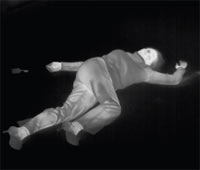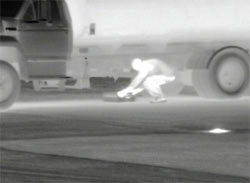
The Heat Is On
Technology advancements bring a new breed of affordable thermal cameras to the market
 When many security professionals think of
thermal security cameras, they think of
exotic cameras with long-range, high-resolution
performance that can cost as much as a nice car
and feature applications befitting their high-end status:
border security, huge industrial facilities and the like.
When many security professionals think of
thermal security cameras, they think of
exotic cameras with long-range, high-resolution
performance that can cost as much as a nice car
and feature applications befitting their high-end status:
border security, huge industrial facilities and the like.
Recent advances in the design, fabrication and mass
production of uncooled thermal detectors—which is usually
one of the most expensive parts of a thermal camera—
have led to a new breed of security camera. These
thermal cameras are based on uncooled vanadium oxide
microbolometer detector technology and are available for
less than you might think, opening up a whole new class
of applications.
The Best Way to See at Night
Thermal security cameras allow people to see what their
eyes can’t—invisible heat radiation emitted by all
objects regardless of lighting conditions. Thermal cameras
detect the minute temperature differences between
objects and turn them into video that can be watched on
almost any TV monitor.
Because they see heat, not light, thermal cameras
are effective security tools in any environment. They
can easily detect intruders and other potential hazards
to the security of a home, day and night, in good
weather and bad.
CCTV cameras and our eyes both make images from
reflected light. This is light energy that hits something,
bounces off, is received by a detector and is then turned
into an image.
Cameras based on visible light have the advantage of
creating images that are familiar and easy to interpret.
Unfortunately, the ability of a given detector—be it in an
eyeball or a camera—to create these images relates
directly to the amount of light available.
At night, for instance, when there isn’t much visible
light to work with, we are limited to starlight, moonlight
and artificial lights to help us see. If there isn’t enough
light, we can’t see.
Another limitation of cameras that create images
from reflected visible light is contrast. Like your eye,
these cameras create better images if the object you are
looking for has lots of contrast compared to its background.
If it doesn’t, you won’t see it. That’s how camouflage
works; camouflage is essentially a way of
decreasing the visible contrast between an object and its
surroundings.
Thermal cameras don’t suffer from the basic limitations
of visible-light imaging, either. First, thermal cameras
make pictures from heat, having nothing to do with
reflected light energy. They see the heat given off by
everything under the sun. Everything encountered in
daily life creates heat energy, called a heat signature, that
a thermal imager can see.
Not only does everything have a heat signature, but
these heat signatures create their own contrast. What’s
more, the thermal energy seen by thermal cameras generally
creates a better image at night than during the day.
They work just fine during the day—as long as there is the
tiniest bit of temperature contrast between an object and
its background, you can see it—but they work best at
night. And nighttime, as we all know, is when security
professionals need the most help to see.
Residential Security
Thermal security cameras are an affordable option for
any homeowner with a security system, and it’s important
for security professionals to understand their technological
advantages over other camera options.
Most people who have been in the security business
for any length of time know that thermal cameras let you
see at night, but that’s only scratching the surface. With
a thermal camera, homeowners can see into those dark,
shadowy nooks and crannies that are common around
house entrances and garages.
With thermal cameras, homeowners can watch property
in ways that visible light cameras can’t, seeing
intruders advancing toward a house without security
lights that are both expensive to install and intrusive to
those living around them.
Most people who buy large pieces of property want
privacy. They don’t want to light themselves and their
neighbors up at night with security lights.
Still, the most common way of seeing around a
house at night is to install clusters of powerful lights.
These may deter intruders, and they do help property
owners and law enforcement personnel to see what’s
going on at night, but security lights have disadvantages.
There are many areas—along waterfronts and
wetlands—where installing an effective lighting infrastructure
is prohibitively expensive.
Even in areas small enough to be illuminated efficiently,
security lights are often counterproductive,
telegraphing the intent to guard something. Whether
they help security professionals see anything with their
visible light cameras at night is debatable.
Security lights may illuminate a residence, but
often they spill over to surrounding properties. This
light pollution is intrusive and often results in unnecessary
tension between homeowners. Thermal cameras,
on the other hand, work without anyone knowing
they are there.
Another benefit of thermal cameras is that they
maintain the privacy of neighbors. Because thermal
cameras can’t identify facial features, homeowners can
use them without sacrificing the modesty of their family
members or that of their neighbors.
When considering which cameras are suitable for
installation in a residential security application, bear in
mind the range requirements. Most residential security
situations don’t need cameras to distinguish whether a
person is carrying a gun or a shovel from 10 miles
away. Their range requirements are much more modest:
a 19- or 35-millimeter lens set coupled with a detector
of 320x240 resolution should be adequate for most situations.
For covering areas with even shorter-range
requirements, like those immediately adjacent to the
residence, you can get sufficient performance out of a
6-millimeter lens and a 160x120 detector.
Welcome to the Dome
When most of us think of domes in the
security world, we think of those smokedplastic
things stuck to the ceiling with an
inexpensive visible light camera inside.
Replacing that visible light camera with a
thermal camera may seem rather counterintuitive
at first—why place a thermal
camera inside?—but thermal can offer
some distinct advantages.
The first thing security professionals
and consumers need to do when contemplating
indoor thermal dome cameras is
to change the mindset about the cameras’
use. Thermal dome cameras play as big a
role in safety as they do in security.
When the lights go out, thermal dome
cameras let security and safety professionals
survey buildings, quickly and safely
ensuring that everyone is out of the area.
Likewise with fire. Thermal cameras
see clearly through smoke—especially
longwave cameras that use inexpensive
VOx detectors—and are perfect tools for
finding people in smoky rooms.
Firefighters have used thermal cameras to
see through smoke for years; thermal cameras
are a proven technology for this application.
With a thermal dome camera, facilities
and security professionals can route
rescue personnel to victims trapped by or
overcome with smoke—without making
them wait for a time-consuming room-toroom
search in order to be rescued.
Indoor thermal dome cameras are
being used for this reason in prisons—
safety and evacuation during fire, not just
security. One prison has dealt with
increasing instances of inmates setting
fire to their mattresses. The dense smoke
from these fires makes it impossible for
corrections officers to use their CCTV
cameras to remotely verify that all
inmates have evacuated the area. To
ensure that all inmates are out, officers
and firefighters must check each cell in
person—a dangerous task in limited visibility.
Once prison and fire officials saw
how well thermal cameras could see
through smoke, their safety advantages
became clear, and the fire marshal mandated
installation.
Another indoor use for thermal cameras
is door access control. Few conditions
are more challenging for a visible light camera than to be inside a building and
looking out an external access door. When
someone opens that door, the visible light
camera quickly becomes oversaturated
with light until its automatic gain controls
can adjust. Then the door closes, and the
camera is plunged into darkness.
Because thermal cameras see heat, not
light, they don’t have any of these limitations.
Coupled with a simple video analytics
tripwire alarm, a thermal dome
camera can give instant and reliable feedback
of door access. Why use a dome for
door monitoring? Good question—most
people opt for a dome because it is more
discreet and harder for people to see.
Plus, it’s always good to have the pan and
tilt capability near an access point.
Thinking Outside the Box
Some people are still stuck in the mindset
that thermal security cameras are only
used for long-range applications and are
so expensive that only governments can
afford them. Thermal cameras see during
the day, at night, and in conditions of limited
visibility like smoke. And, they’re
inexpensive enough to be used anywhere,
even at home.
As an illustration, no one would have
considered using a thermal camera in an
agricultural setting only a few years ago,
but an exciting and emerging market for
thermal security cameras now is on ranch
and range land. Cattle and horses are
expensive investments, and farmers and
ranchers can’t risk losing them to theft,
vandalism, poaching or predators.
By installing some affordable VOx
thermal security cameras in a barn or in
more remote pastures, farmers can watch
over their animals and help ensure against
their loss.
Because uncooled VOx thermal security
cameras are affordable and widely
available, uses are only limited by the
security professional’s ability to think
outside the box. Investigate this exciting,
affordable technology,
and your imagination
will run wild.
This article originally appeared in the issue of .